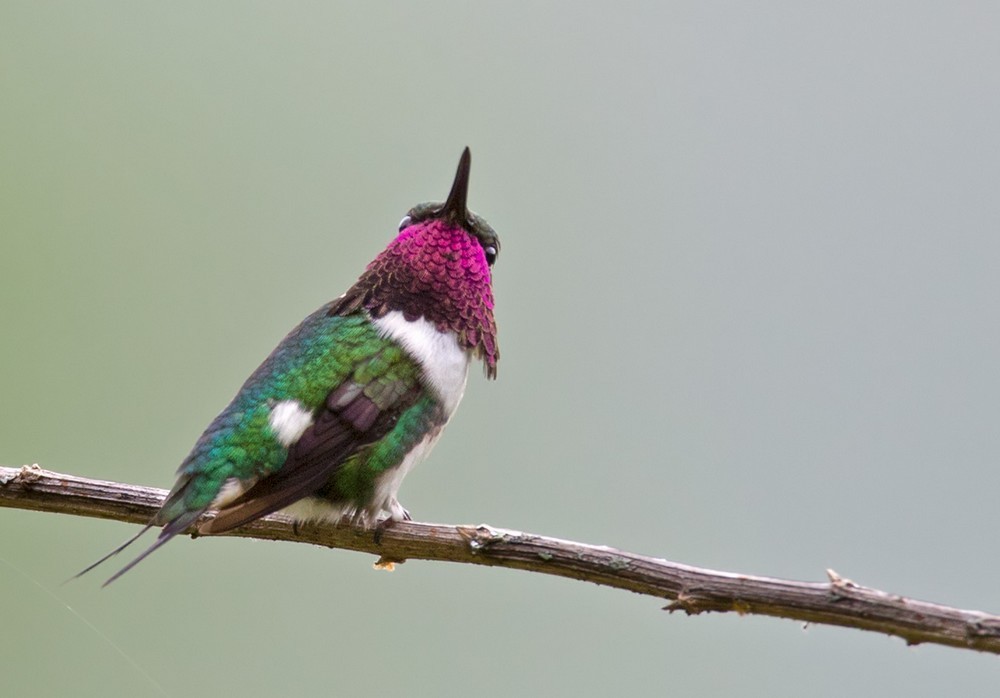Esmeraldas Woodstar
A species of Chaetocercus Woodstars Scientific name : Chaetocercus berlepschi Genus : Chaetocercus Woodstars
Esmeraldas Woodstar, A species of Chaetocercus Woodstars
Botanical name: Chaetocercus berlepschi
Genus: Chaetocercus Woodstars
Content
Description General Info
 Photo By Lars Petersson
Photo By Lars Petersson Description
At only about 6 centimeters long, Esmeraldas woodstars are among the smallest species of hummingbird. Researchers recently found Esmeraldas woodstars at twelve new locations and collected the first female specimens of the species. Previously, the specimens labelled as female were misgendered juvenile males. Female Esmeraldas woodstars have yellowish-brown underparts and a dark greyish-black back, head, and tail. They have green patches on the sides of their chest and the center of their tail. Their tails also have small, cinnamon-rufous tips. They have a white postocular stripe (differently coloured feathers extending from the eye down to the neck). Little woodstars inhabit the same region as Esmeraldas woodstars, and the females of both species appear very similar to each other. Distinguishing features of little woodstar females are their green sheen, cinnamon postocular stripe which is short and narrow (rather than long and wide), cinnamon underparts, and larger size. Male Esmeraldas woodstars have green upperparts with a blue sheen, white underparts, a white postocular stripe, a green chest band, a forked tail and a bright purple throat. Male little woodstars also appear very similar to male Esmeraldas woodstars. In contrast, male little woodstars have ruby-pink throats and are greener on both their upper- and underparts. Male juvenile Esmeraldas woodstars were previously misidentified by researchers as adult females because of their similar appearance and extremely small gonads. Male juveniles have white underparts, a yellowish-brown throat with a few purple feathers, and a distinctive rounded, green tail with a rufous-cinnamon base and pale cinnamon to whitish tips. Young Esmeraldas woodstars that are still nest-bound have yellowish-brown underparts with green and cinnamon wings. Male Esmeraldas woodstars that have recently left their nest are similar to male juveniles but without the purple feathers on their throat. 
Size
7 cm
Nest Placement
Tree
Feeding Habits
Esmeraldas Woodstar mostly feeds on the nectar of specific plants including Kohleria spicata, Cornutia pyramidata, Psychotria hazennii, and Razisea cf. ericae, showing a preference for flowers that bloom at peak times, particularly from January to March.
Habitat
The habitat of esmeraldas Woodstar typically encompasses evergreen pre-montane and montane forests, predominating at lower elevational zones. They are adapted to environments ranging from undisturbed to moderately disturbed areas, with a proclivity for riparian zones and secondary growth forests. These birds thrive in regions characterized by humid and dense vegetation, usually associated with broad leafy greenery.
Dite type
Nectivorous
General Info
Feeding Habits
Bird food type
Distribution Area
Esmeraldas woodstars are found only on the Pacific coast of western Ecuador. They occupy a small range which has been mostly deforested. Their range overlaps with the little woodstar. Esmeraldas woodstars inhabit semi-deciduous to evergreen moist forests. They are found anywhere between sea level and 750 meters in elevation. This includes both low elevation areas which have been disturbed by human settlement, and undisturbed, high elevation areas. 
Species Status
The IUCN Red List classifies the Esmeralda woodstar as Vulneerable. They were previously believed to have a population of 250 to 999 individuals. These numbers would deem them almost critically endangered. After an extensive study in 2009, researchers concluded that their population size is likely 1,000 to 3,000. This would make them less threatened than previously thought but still a high priority conservation species. Their population is currently decreasing. Habitat protection is crucial for Esmeraldas woodstar survival. Research shows that crucial breeding areas for this species include the cities of San José to San Lorenzo and the large forest patches adjacent to them. Machalilla National Park is one of the only areas protecting this species from habitat loss, but it needs better management to be successful. In 2014, a 38-acre nature reserve was created in Ayampe by Fundación de Conservación Jocotoco, Rainforest Trust, the American Bird Conservancy, and the local Las Tunas community. Their goal is to protect 700 acres of land. 

 Photo By Lars Petersson
Photo By Lars Petersson Scientific Classification
Phylum
Chordates Class
Birds Order
Swifts and hummingbirds Family
Hummingbirds Genus
Chaetocercus Woodstars Species
Esmeraldas Woodstar